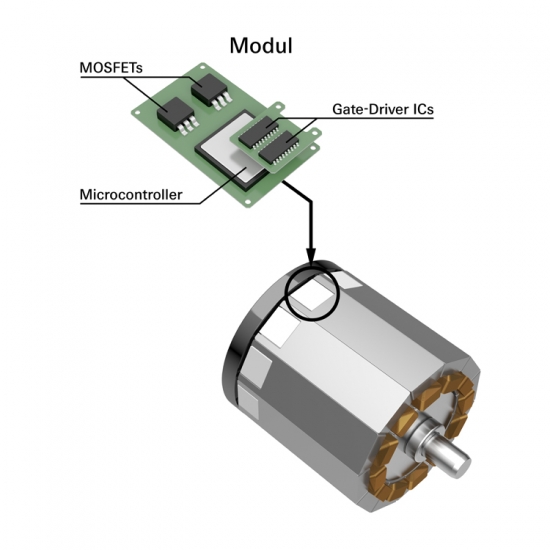Headed by ZF with a 10 million Euros support
Market opportunities for electric vehicles will be enhanced if they become more powerful, more reliable, and less expensive. "EMiLE", the research project headed by ZF and supported with around EUR 10 million by the German Federal Ministry of Education and Research (BMBF), is examining how this could work. The aim is to integrate an electric vehicle´s power electronics directly into the driving machine. Efficiency and power-to-weight ratio increase as a consequence, faults are easier to identify, and volume production can be realized at significantly lower cost.
Currently, the power electronics for the electric driveline in electric vehicles is located in a separate housing which is connected to the electric driving machine by cable. This solution requires space for the electronics, and in addition, the cables add to costs, increase weight, and raise susceptibility to faults. Initial solutions where the electronics are attached to the motor housing already indicate that this does not have to be the case. As part of the "Electric motor integrated power electronics" project ("EMiLE"), the consortium of partners led by ZF Friedrichshafen AG aims to take a step further: The power electronics is to be integrated for the most part directly into the driving machine.
The technologies required for this will be researched in collaboration with the following partners from industry: AixControl GmbH, Infineon Technologies AG, Lenze SE, Robert Bosch GmbH, Siemens AG, TDK-EPC Corporation, Volkswagen AG, the Fraunhofer Institute for Integrated Systems and Device Technology (IISB), and the Institute for Power Electronics and Electrical Drives (ISEA) at the RWTH Aachen university. The strategy and content of the "EMiLE" project have been developed in close coordination with working group 1 of the German national e-mobility platform. Its various working groups examine important topics in the field of e-mobility and their findings are reported directly to the government.
Cooperation with its many advantages
The objective of the funding provided by the BMBF is to pave the way for a teamwork approach with potential applications in practice by establishing cooperation between research institutes, German car companies, and automotive suppliers at an early stage along the entire value-added chain, from assembly to the electrical drive system. Moreover, the project is enabling a significant transfer of knowledge in the area of e-mobility. However, if the power electronics is integrated directly into the driving machine, it is not only electric vehicles that benefit. The advantages can also be of benefit specifically in terms of greater efficiency and more cost-effective production in industrial automation technology.
Direct integration of power electronics
If the power electronics is situated close to the driving machine on the stator windings, many advantages accrue: Converters supplying the electric motor with power can be integrated with fewer interfaces. This reduces installation space, weight, and has a positive effect on total costs - as compared with separate individual systems. Additionally, potential EMC (electromagnetic compatibility) radio-interference sources are removed since there is no need in the vehicle for motor cables charged with interference currents. Yet, at the same time, thermal and mechanical demands on the power electronics increase.
The "EMiLE" project aims, however, to achieve even more: The partners have set themselves the goal of integrating the power electronics directly into the driving machine. Thus, the number of individual interfaces and components can be reduced further. Finally, there is also the potential of using pre-assembled individual systems for simpler production. In addition, further advantages in the areas of fault control, redundancy, functional safety, and system efficiency are expected.
The objectives of the "EMiLE" project are clearly defined: The systems power-to-weight ratio of converters and electric motors is to increase by up to 50 percent - and this with 40 percent lower systems costs as compared with separate subsystems. It is intended to demonstrate these improvements both for use in the passenger car field and for application in industry.


